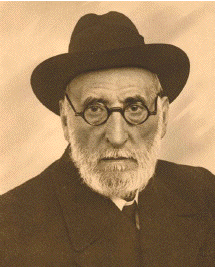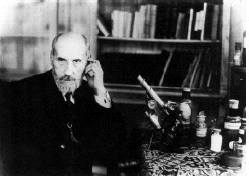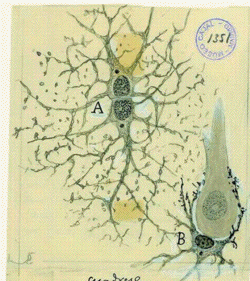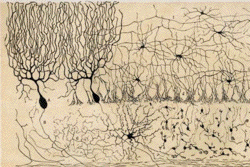  - Marina Bentivoglio :
- Santiago Ramón y Cajal was born in
May 1852 in the village of Petilla, in the
region of Aragon in northeast Spain. His father
was at that time the village surgeon (later on,
in 1870, his father was appointed as Professor
of Dissection at the University of Zaragoza).
Cajal was a rebellious teenager, and his father
apprenticed him for a while to a shoemaker and
to a barber. Cajal, however, had decided to
become an artist. His passion for drawing, his
sensitivity to visual esthetics and his talent
in converting visual images into drawings
remained the hallmarks of his future scientific
activity. Finally enrolled in the medical school
at Zaragoza, as a young student, Cajal, seized
by a "graphic mania," was very fond of
philosophy and gymnastics, restless, energetic,
shy and solitary. He graduated in medicine at
the University of Zaragoza in 1873. Shortly
after his degree he was drafted into the army
and dispatched to Cuba, at that time under
Spanish rule, as a medical officer. Cajal
returned to Spain very sick (he had contracted
malaria in Cuba, and then tuberculosis), and at
the end of 1875 he started his academic career
as "Auxiliary Professor" of Anatomy at the
University of Zaragoza.
-

- In Zaragoza, Cajal purchased in 1877 with
his own funds ("using every peseta saved from
the service in Cuba"), an old-fashioned
microscope and started his scientific activity.
His first studies were devoted to inflammation
and to the structure of muscle fibers. In 1883,
Cajal was appointed to the chair of Anatomy in
Valencia. In 1885, during his tenure as
Professor at the University of Valencia, the
Provincial Government of Zaragoza, in
recognition of his labor during a cholera
epidemic, awarded him with a modern Zeiss
microscope. At the end of 1887 Cajal moved to
Barcelona, where he accepted the chair of Normal
and Pathological Histology, and in 1892 he was
appointed Professor of Histology and
Pathological Anatomy at the University of
Madrid. Cajal continued to work productively in
Madrid until his death in 1934.
-
- A flash of lightning
- The key event for Cajal's scientific career
and for the development of modern neuroscience
took place in Madrid in 1887, when Cajal was 35
years old. In this year, Luis Simarro Lacabra, a
brilliant psychiatrist interested in
histological research, showed to Cajal, who had
traveled from Valencia to get an update on
technological advances, material impregnated
with the Golgi staining. Dr. Simarro had just
returned from Paris, and had brought specimens
stained by the new technique of silver
impregnation (the reazione nera), that had been
discovered 14 years earlier by Camillo Golgi but
still had a very limited diffusion. Cajal wrote
in his autobiography "it was there, in the house
of Dr. Simarro...that for the first time I had
an opportunity to admire...those famous sections
of the brain impregnated by the silver method of
the Savant of Pavia."
-
- At the time, Cajal had only been studying
the nervous system for one year, mainly to
collect suitable illustrations for a book of
histological techniques, and he had realized how
inadequate the ordinary methods were to study
the nervous tissue. The observation of
preparations impregnated by the Golgi stain was
a flash of lightning: "a look was enough" and
Cajal was enraptured. Nerve cells appeared
"coloured brownish black even to their finest
branchlets, standing out with unsurpassable
clarity upon a transparent yellow background.
All was sharp as a sketch with Chinese ink,"
Cajal wrote in his autobiography. In a feverish
burst of activity ("...as new facts appeared in
my preparations, ideas boiled up and jostled
each other in my mind. A fever for publication
devoured me"), Cajal worked on the retina, the
cerebellum and the spinal cord, applying to the
tissue the Golgi stain, of which he worked out
some modifications.
-
- An indefatigable and creative
scholar
-
- In October 1889, Cajal who had never
traveled outside Spain except for his service in
Cuba, went to Berlin, to the Congress of the
German Anatomical Society, to show his slides to
the leading authorities in the field, in order
to convince them of the importance of his
observations. On this occasion, he obtained the
recognition of several qualified professors,
including the eminent Swiss histologist Rudolf
Albert von Kölliker (1817-1905), who from
there on became a supporter of Cajal and of the
"neuron doctrine," which would be officially
enunciated by Wilhelm Waldeyer (1836-1921) in
1891.
-
- Cajal was fiercely opposed to the idea that
the nervous system was made up a network of
continuous elements, as it had been stated by
Joseph von Gerlach (1820-1896) and supported by
Golgi himself. Camillo Golgi had believed to
have found in his own preparations the
demonstration that the nervous system was made
of a widespread network of filaments in
continuity one with the other (the rete nervosa
diffusa, 'diffuse neural network'). On the
contrary, since the first observations and in
his subsequent studies, Cajal's imagination was
fired by the idea that the nervous system is
made up of billions of separate nerve cells.
Cajal's work led to the conclusion that the
basic units of the nervous system were
represented by individual cellular elements
(which Waldeyer christened as "neurons" in
1891). This conclusion is the modern basic
principle of the organization of the nervous
system.
- Cajal's opus "Textura del Sistema
Nervioso del Hombre y los Vertebrados"
(1894-1904), was made available to the
international scientific community in its French
translation, "Histologie du Système
Nerveux de l'Homme et des
Vertébrés", (translated by L.
Azoulay, published in 1911 by Maloine, Paris;
the English translation, by N. and L.W. Swanson,
was published in 1994 by Oxford University
Press). Cajal's opus provided the foundation of
modern neuroanatomy, with a detailed description
of nerve cell organization in the central and
peripheral nervous system of many different
animal species, and was illustrated by Cajal's
renowned drawings, which for decades (and even
nowadays) have been reproduced in neuroscience
textbooks.
-
- In addition, Cajal defined "the law of
dynamic polarization," stating that the nerve
cells are polarized, receiving information on
their cell bodies and dendrites, and conducting
information to distant locations through axons,
which turned out to be a basic principle of the
functioning of neural connections. Cajal also
made fundamental observations on the development
of the nervous system and its reaction to
injuries (his volume "Degeneration and
Regeneration of the Nervous System" translated
and edited by R. M. May, London, Oxford
University Press, 1928, has been re-edited by J.
DeFelipe and E.G. Jones, Oxford University
Press, 1991).
-
- Golgi and Cajal, who shared the Nobel Prize
in 1906 for their studies on the nervous system,
met only in Stockholm, to receive the award.
Golgi gave his Nobel lecture first, in which he
tied to his belief in "reticular" neural
networks, which was entirely contradicted by
Cajal's Nobel lecture. Cajal, a strenuous
supporter of the contiguity (and not the
continuity) of individual cells representing the
basic units of the nervous system, fought for
his ideas until his death.
-
- Golgi and Cajal certainly shared the same
passion for science and dedication to science
but their personalities were very different.
Cajal, impetuous, burning with enthusiasm,
dedicated his life to the study of the
organization of the nervous system, on which he
made fundamental discoveries with his peculiar
talent and intuition. Golgi, a "cooler"
academic, discovered the tool used by Cajal in
his studies and provided outstanding
contributions in many fields of cell biology and
of pathology, and important contributions also
on the structure of the nervous system (such,
for example, the description of branches given
off by the axon, of different types of neurons,
of glial cells). However, Golgi misinterpreted
the overall view of the structural organization
of the nervous system, which instead has been
worked out by Cajal.
-
- Extremely productive, Cajal was also an
accomplished photographer (his photographs of
Spain, villages, friends, faces, are kept at the
Cajal Museum in Madrid), and he wrote several
books destined to a not strictly scientific wide
audience, including his autobiography
"Recollections of My Life" (Recuerdos de mi
vida, translated by E.H. Craigie with the
assistance of J. Cano, MIT Press, Cambridge,
Mass., 1989), a small volume of aphorisms
("thoughts, anecdotes and confidences," as
stated in the subtitle) entitled "Coffee
Chatters" (Charlas de Café), "The world
seen at 80 years" ("El mundo visto a los ochenta
años," with the ironic subtitle of
"Impresiones de un
Arteriosclerótico").
-
 
|







